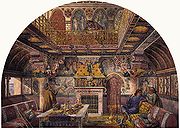Axel Haig
Axel Haig | |
|---|---|
Gothic Revival |
Axel Herman Haig
Life
Haig was born at
The middle years of the nineteenth century saw an explosion in the practice of architectural competitions. The wealth generated by the empire and the Industrial Revolution created the necessary conditions for a vast expansion in civic construction. Commissions for government offices, town halls, churches for private benefactors, railway termini were all put out to tender and competing architects required draughtsmen to illustrate their plans. In 1866 Haig met architect and designer William Burges (1827–1881) when Burges retained him to illustrate his designs for the Royal Courts of Justice in The Strand.[4] Haig produced a series of watercolour illustrations that were "an immediate sensation."[1] The competition's winner, George Edmund Street, is said to have remarked, "I wouldn't mind being beaten by drawings like those."[1]
In 1875, Haig made study trips to
Haig developed a second career as an etcher and his drawings and lithographs of European castles, palaces, landscapes and cathedrals became hugely popular in late-Victorian England. He was elected as a member of the Royal Society of Painter-Etchers.[1]
Haig was mostly a resident of England, but spent the summers at the family farm on Gotland. Floda Church at Södermanland, Sweden, was rebuilt and underwent restoration between 1885 and 1888 on the basis of his drawings.[6]
Haig also designed All Saints' Church, Grayswood, Surrey. It was built between 1901 and 1902 in a style described variously as Surrey Vernacular[7] or "13th-century [Gothic] with Arts and Crafts elements". Haig is buried in the graveyard. The church is a Grade II listed building.[8]
In a review of Haig's work published by the Royal Institute of British Architects in the year of his death, Maurice Adams wrote that "his architectural draughtsmanship ranks without a doubt amongst the foremost of his time and his graphic capability remains unique."[9]
Gallery
-
Floda Church in Södermanland
-
Haig's illustration for the Summer Smoking Room at Cardiff Castle
-
All Saints Church designed by Haig in his adopted village of Grayswood
-
Haig's headstone
References
- ^ a b c d e f g h Mordaunt Crook et al. 1984, p 13
- ^ Jonas Gavel. "Axel Herman Hägg". Svenskt biografiskt lexikon. Retrieved 1 January 2019.
- ^ "Per Magnus Arvid Säve". Svenskt biografiskt handlexikon. Retrieved 1 January 2019.
- ^ Axel Haig and the Victorian Vision of the Middle Ages page 16
- ^ Axel Haig and the Victorian Vision of the Middle Ages page 17
- ^ "Floda kyrka". christermalmberg.se. Retrieved 1 January 2019.
- ^ Nairn & Pevsner 1971, p. 262.
- ^ Historic England. "Church of All Saints, Grayswood Road, Grayswood (Grade II) (1243910)". National Heritage List for England. Retrieved 2 June 2014.
- ^ Journal of the Royal Institute of British Architects, Volume XXVIII (1921)
Sources
- Armstrong, E.A, Axel Herman Haig and His Works (1905) The Fine Art Society, Ltd
- George Allen and Unwin
- ISBN 0-300-09675-5.




